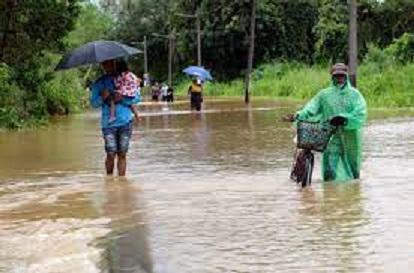Africa-Press – Mauritius. All the blame for the recurrent distress that torrential rains bring in their wake around the island – major parts of the South of the island were under water this week – cannot be pinned down on any one institution given the multifactorial causes of such disasters, including institutional slack and/or overlapping, town and country planning deficiencies, budgetary constraints, etc.
Moreover, inadequate planning in construction, alteration of the natural courses of water in order to make way for infrastructure, loss of wetland, blocking of drains with debris have made Mauritius prone to flooding.
Additionally, for the past few years, Mauritius has been experiencing an increase in the frequency of high intensity rainfall events which resulted in flash floods on several occasions.
The National Disaster Risk Reduction and Management Centre has identified 65 regions as flood prone areas throughout the island. The government however cannot shirk responsibility for the mess many regions find themselves in after heavy downpours.
It is the Ministry of Public Utilities which has been given the mandate to work out and implement plans to prevent floods, or at least to minimise them to the point of eliminating their catastrophic effects – not just in Port Louis as it happened in 2013 at Caudan, but also everywhere else in the island.
Successive governments were expected to take appropriate and effective action on the findings and recommendations of different studies that had been commissioned to help address this issue – for instance, the Gibb report “Study of Land Drainage System of Mauritius”, released in April 2003 – itself preceded by an advance report of the Consultant’s findings on flood prone areas.
Little is known about what has been done concretely to mitigate the problem, but in the meantime billions have been earmarked for infrastructure works, especially in the construction of drains around the island, most notably in the 2021 budget.
Even if many parts of the island remain to date vulnerable to such disasters as happened this week, where drain construction works have been implemented, for instance at Trois Boutiques, the inhabitants have been spared of the distress of earlier years in the wake of heavy downpours.
There had also been earlier Justice Domah’s Fact-Finding Committee, which was set up in March 2008 after floods in the north of the island, particularly at Mon Goût.
The Domah report, released on 23 March 2009, highlighted the “systemic gaps” that led to such disasters and advocated an integrated strategy for the management of natural risks, to replace the approach adopted so far which remains only “defensive and reactive”. How much has been achieved in the implementation of Justice Domah’s recommendations is not known.
For More News And Analysis About Mauritius Follow Africa-Press







